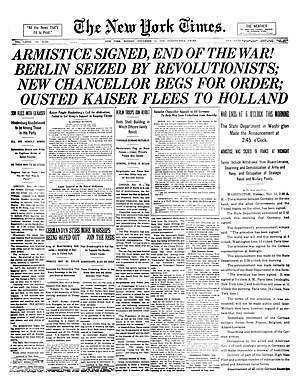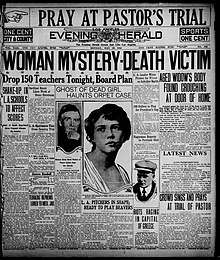Headline
The headline or heading is the text indicating the nature of the article below it.
The large type front page headline did not come into use until the late 19th century when increased competition between newspapers led to the use of attention-getting headlines.
It is sometimes termed a news hed, a deliberate misspelling that dates from production flow during hot type days, to notify the composing room that a written note from an editor concerned a headline and should not be set in type.[1]
Headlines in English often use a set of grammatical rules known as headlinese, designed to meet stringent space requirements by, for example, leaving out forms of the verb "to be" and choosing short verbs like "eye" over longer synonyms like "consider".
Production

A headline's purpose is to quickly and briefly draw attention to the story. It is generally written by a copy editor, but may also be written by the writer, the page layout designer, or other editors. The most important story on the front page above the fold may have a larger headline if the story is unusually important. The New York Times's 21 July 1969 front page stated, for example, that "MEN WALK ON MOON", with the four words in gigantic size spread from the left to right edges of the page.[2]
The film The Shipping News has an illustrative exchange between the protagonist, who is learning how to write for a local newspaper, and his publisher:
Publisher: It's finding the center of your story, the beating heart of it, that's what makes a reporter. You have to start by making up some headlines. You know: short, punchy, dramatic headlines. Now, have a look, [pointing at dark clouds gathering in the sky over the ocean] what do you see? Tell me the headline.
Protagonist: HORIZON FILLS WITH DARK CLOUDS?
Publisher: IMMINENT STORM THREATENS VILLAGE.
Protagonist: But what if no storm comes?
Publisher: VILLAGE SPARED FROM DEADLY STORM.
In the United States, headline contests are sponsored by the American Copy Editors Society, the National Federation of Press Women, and many state press associations.
The need to keep headlines brief occasionally leads to unintentional double meanings, if not double entendres. For example, if the story is about the president of Iraq trying to acquire weapons, the headline might be IRAQI HEAD SEEKS ARMS, or if some agricultural legislation is defeated in the United States House of Representatives, the title could read FARMER BILL DIES IN HOUSE.
Famous examples
Some famous headlines in periodicals include:
- WALL ST. LAYS AN EGG – Variety on Black Monday (1929)
- STICKS NIX HICK PIX – Variety writing that rural moviegoers preferred urban films (1935)
- DEWEY DEFEATS TRUMAN – Chicago Tribune reporting the wrong election winner (1948)
- FORD TO CITY: DROP DEAD – New York Daily News reporting the denial of a federal bailout for bankrupt New York City (1975)
- MUSH FROM THE WIMP – The Boston Globe in-house joke headline for an editorial, not changed before 161,000 copies printed. Theo Lippman Jr. of the Baltimore Sun declared "Mush from the Wimp" the second most famous newspaper headline of the 20th century, behind "Wall St. Lays an Egg" and ahead of "Ford to City: Drop Dead".[3]
- HEADLESS BODY IN TOPLESS BAR – New York Post on a local murder (1983)[4]
- SICK TRANSIT'S GLORIOUS MONDAY – New York Daily News front-page caption on a photo (1979) reporting an agreement to avoid fare increases and provide federal funding[5]
- GOTCHA! – The UK Sun on the torpedoing of the Argentine ship Belgrano and sinking of a gunboat during the Falklands War (1982)
- FREDDIE STARR ATE MY HAMSTER – The UK Sun (1986), claiming that the comedian had eaten a fan's pet hamster in a sandwich. The story was later proven false, but is seen as one of the classic tabloid newspaper headlines.[6]
- GREAT SATAN SITS DOWN WITH THE AXIS OF EVIL – The Times (UK) on US-Iran talks (2007)[7]
- SUPER CALEY GO BALLISTIC CELTIC ARE ATROCIOUS – Sun on Inverness Caledonian Thistle beating Celtic in the Scottish Cup[8]
- WE ARE POPE (in German: Wir sind Papst); Bild after a German was voted to become pope Benedikt XVI in 2005.
Editor of The New Republic, Michael Kinsley, began a contest to find the most boring newspaper headline.[9] According to him, no entry surpassed the one that had inspired him to create the contest: "WORTHWHILE CANADIAN INITIATIVE",[10] over a column by The New York Times' Flora Lewis.[11]
Typology
Research in 1980 classified newspaper headlines into four broad categories: questions, commands, statements, and explanations.[12] Advertisers and marketers classify advertising headlines slightly differently into: questions, commands, benefits, news/information, and provocation.[13]
Headlinese

Headlinese is an abbreviated form of news writing style used in newspaper headlines.[14] Because space is limited, headlines are written in a compressed telegraphic style, using special syntactic conventions,[15] including:
- Forms of the verb "to be" and articles (a, an, the) are usually omitted.
- Most verbs are in the simple present tense, e.g. "Governor signs bill", while the future is expressed by an infinitive, with to followed by a verb, as in "Governor to sign bill".
- The conjunction "and" is often replaced by a comma, as in "Bush, Blair laugh off microphone mishap".[16]
- Individuals are usually specified by surname only, with no honorifics.
- Organizations and institutions are often indicated by metonymy: "Wall Street" for the US financial industry, "Whitehall" for the UK government administration, "Madrid" for the government of Spain, "Davos" for World Economic Forum, and so on.
- Many abbreviations, including contractions and acronyms, are used: in the US, some examples are Dems (for "Democrats") and GOP (for the Republican Party from the nickname "Grand Old Party"); in the UK, Lib Dems (for the Liberal Democrats), Tories (for the Conservative Party). The period (full point) is usually omitted from these abbreviations, though U.S. may retain them, especially in all-caps headlines to avoid confusion with the word us.
- Lack of a terminating full stop (period) even if the headline forms a complete sentence.
Some periodicals have their own distinctive headline styles, such as Variety and its entertainment-jargon headlines, most famously "Sticks Nix Hick Pix".
Commonly used short words
To save space, headlines often use extremely short words (many of which are not in common use otherwise) in unusual or idiosyncratic ways:
- axe (eliminate)
- bid (attempt)
- blast (heavily criticize)
- cagers (basketball team – "cage" is an old term for indoor court)[17]
- chop (eliminate)
- confab (meeting)[18]
- eye (consider)
- fold (shut down)
- gambit (attempt)
- hike (increase)
- ink (sign a contract)
- laud (to praise)
- lull (a pause)
- mar (to damage, harm)
- mull (contemplate)
- nab (grab)
- nix (reject)
- parley (meeting)
- pen (write)
- rap (criticize)
- see (forecast)
- slam (heavily criticize)
- solon (judge)
- tap (select e.g. an appointee)
- tout
Many verbs can be converted into nouns, e.g. "rap" could be understood as either "criticize" or "criticism" depending on context.
Criticism
"Slam"
The use of "slam" in headlines has attracted criticism on the grounds that the word is overused and contributes to media sensationalism.[19][20] The violent imagery of words like "slam", "blast", "rip", and "bash" has drawn comparison to professional wrestling, where the primary aim is to titillate audiences with a conflict-laden and largely predetermined narrative rather than provide authentic coverage of spontaneous events.[21]
Crash Blossoms
'Crash Blossoms' is a term used to describe headlines that have unintended ambiguous meanings, such as The Times headline "Hospitals named after sandwiches kill five". The word 'named' is typically used in headlines to mean "blamed/held accountable/named [in a lawsuit]",[22] but in this example it seems to say that the hospitals' names were related to sandwiches. The headline was subsequently changed in the electronic version of the article to remove the ambiguity.[23]
This term was coined in August 2009 in the Testy Copy Editors forum.[24] The term comes from the headline of a Japan Times article which was worded "Violinist Linked to JAL Crash Blossoms".[25] The article has since been re-titled.[26]
See also
- A-1 Headline, a 2004 Hong Kong film
- Betteridge's law of headlines – An adage that states: "Any headline that ends in a question mark can be answered by the word no."
- Bus plunge, a type of news story, and accompanying headline
- Copy editing
- Corporate jargon
- Dateline
- Ellipsis (linguistics), omission of words
- Headlines (from The Tonight Show with Jay Leno)
- Journalese
- Lead paragraph
- Nut paragraph
- Syntactic ambiguity, leads to multiple humorous possible alternative interpretations of written headline
References
- NY Times: On Language: HED
- Wilford, John Noble (14 July 2009). "On Hand for Space History, as Superpowers Spar". The New York Times. Retrieved 24 April 2011.
- Scharfenberg, Kirk (1982-11-06). "Now It Can Be Told . . . The Story Behind Campaign '82's Favorite Insult". The Boston Globe. Boston, Massachusetts. p. 1. Retrieved 2011-01-20. Abstract only; no article without payment.
- Fox, Margalit (2016-06-09). "Vincent Musetto, 74, Dies; Wrote 'Headless' Headline of Ageless Fame". The New York Times.
- Daily News (New York, NY), 9/25/1979, p.1
- "Telegraph wins newspaper vote". BBC News. 25 May 2006.
- Great Satan sits down with the Axis of Evil
- "Super Caley dream realistic?". BBC. 22 March 2003.
- Kinsley, Michael (1986-06-02). "Don't Stop The Press". The New Republic. Retrieved April 26, 2011.
- Lewis, Flora (4 October 1986). "Worthwhile Canadian Initiative". The New York Times. Retrieved 9 March 2013.
- Kinsley, Michael (28 July 2010). "Boring Article Contest". The Atlantic. Retrieved 26 April 2011.
- Davis & Brewer 1997, p. 56.
- Arens 1996, p. 285.
- Headlinese Collated definitions via www.wordnik.com
- Isabel Perez.com: "Newspaper Headlines"
- "Bush, Blair laugh off microphone mishap". CNN. July 21, 2006. Archived from the original on August 16, 2007. Retrieved July 17, 2007.
- "When the Court was a Cage", Sports Illustrated
- "Is confab still used?"
- Ann-Derrick Gaillot (2018-07-28). "The Outline "slams" media for overusing the word". The Outline. Retrieved 2020-02-24.
- Kehe, Jason (9 September 2009). "Colloquialism slams language". Daily Trojan.
- Russell, Michael (8 October 2019). "Biden 'Rips' Trump, Yankees 'Bash' Twins: Is Anyone Going to 'Slam' the Press?". PolitiChicks.
- Pérez, Isabel. "Newspaper Headlines". English as a Second or Foreign Language. Retrieved 31 March 2020.
- Brown, David (18 June 2019). "Hospital trusts named after sandwiches kill five". The Times. Retrieved 31 March 2020.
- Zimmer, Ben (Jan 31, 2010). "Crash Blossoms". New York Times Magazine. Retrieved 31 March 2020.
- subtle_body; danbloom; Nessie3. "What's a crash blossom?". Testy Copy Editors. Retrieved 31 March 2020.
- Masangkay, May (18 August 2009). "Violinist shirks off her tragic image". The Japan Times. Retrieved 31 March 2020.
Sources
- Arens, William F. (1996). Whidden, Jack J. (ed.). Contemporary Advertising. The Irwin series in marketing (6th ed.). Irwin. ISBN 9780256182576.CS1 maint: ref=harv (link)
- Davis, Boyd H.; Brewer, Jeutonne Patten (1997). Electronic Discourse: Linguistic Individuals in Virtual Space. SUNY Press. ISBN 9780791434758.CS1 maint: ref=harv (link)
Further reading
- Harold Evans (1974). News Headlines (Editing and Design : Book Three) Butterworth-Heinemann Ltd. ISBN 0-434-90552-6, 978-0-434-90552-2
- Fritz Spiegl (1966). What The Papers Didn't Mean to Say. Scouse Press, Liverpool ISBN 0901367028
- Mårdh, Ingrid (1980); Headlinese: On the Grammar of English Front Page headlines; "Lund studies in English" series; Lund, Sweden: Liberläromedel/Gleerup; ISBN 91-40-04753-9
- Biber, D. (2007); "Compressed noun phrase structures in newspaper discourse: The competing demands of popularization vs. economy"; in W. Teubert and R. Krishnamurthy (eds.); Corpus linguistics: Critical concepts in linguistics; vol. V, pp. 130–141; London: Routledge
External links
| Look up headline in Wiktionary, the free dictionary. |
- Front Page – The British Library Exhibition of famous newspaper headlines